

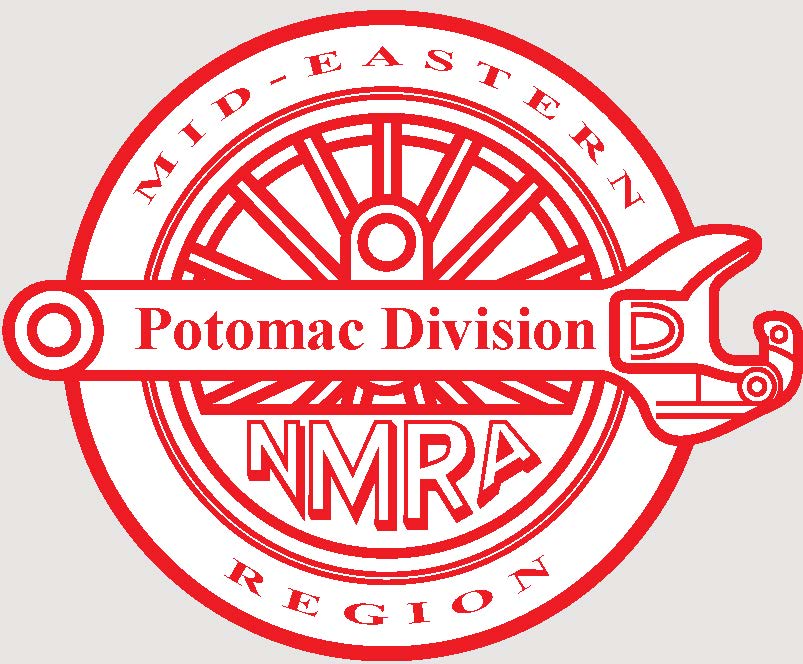
Model Railroads Near and About the Nation's Capital
Click on name for more information and link to siteHome pages marked with * are hosted for free by the Division, click here for more information.
Model Railroads Near Washington, DC|
|

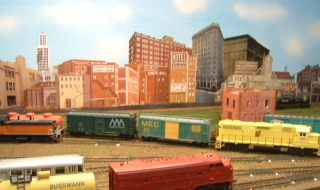 The late Marshall Abrams was the proprietor of
the fallen model railroad Abrams
Railroad Empire (ARE) which modeled the
"Anachronistic Era." It's was a 20 foot by 22 foot
walk-around HO layout that focused on operations using Car
Cards and DCC in 5 operating yards and 7 towns. Track
Warrants were used to protect key single line blocks. The
switching was power routed, controlled by strategically
placed CTC panels for yards and mainline. Scenery features
included a urban backdrop and a cut-away tunnel. The ARE
provided the crews with a a fun night of comraderie and
challenges during the operating sessions and often made
you wish you had more time to run trains ! The late Marshall Abrams was the proprietor of
the fallen model railroad Abrams
Railroad Empire (ARE) which modeled the
"Anachronistic Era." It's was a 20 foot by 22 foot
walk-around HO layout that focused on operations using Car
Cards and DCC in 5 operating yards and 7 towns. Track
Warrants were used to protect key single line blocks. The
switching was power routed, controlled by strategically
placed CTC panels for yards and mainline. Scenery features
included a urban backdrop and a cut-away tunnel. The ARE
provided the crews with a a fun night of comraderie and
challenges during the operating sessions and often made
you wish you had more time to run trains ! |
|
|
top |
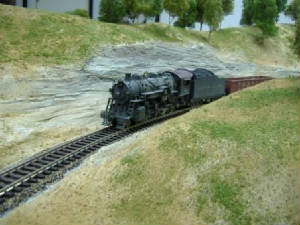 The
Baltimore
&
Ohio's Monongah Division is an HO model railroad,
set in West Virginia, circa the mid-1950s. The
B&O’s lines south of Grafton, West Virginia, ran on
light rail and tight curves. On the Monongah
Division we run regular operating sessions using Digitrax
DCC. All operations are by waybill and sequential
timetable. In addition to the requisite coal
traffic, there are local freights, traffic between
Charleston and Grafton, an interchange with the Western
Maryland, and rudimentary passenger service.
I model the area near Buckhannon, with Grafton and
Charleston as staging tracks at the end of the
layout. The layout attempts to capture the backwoods
feel of these lines, without getting picky about the
actual trackwork or geography of any locale. Between
yard duties, the local freights, and the through trains, I
can keep about three crews running.
Proprietor: Dean Ripple
The
Baltimore
&
Ohio's Monongah Division is an HO model railroad,
set in West Virginia, circa the mid-1950s. The
B&O’s lines south of Grafton, West Virginia, ran on
light rail and tight curves. On the Monongah
Division we run regular operating sessions using Digitrax
DCC. All operations are by waybill and sequential
timetable. In addition to the requisite coal
traffic, there are local freights, traffic between
Charleston and Grafton, an interchange with the Western
Maryland, and rudimentary passenger service.
I model the area near Buckhannon, with Grafton and
Charleston as staging tracks at the end of the
layout. The layout attempts to capture the backwoods
feel of these lines, without getting picky about the
actual trackwork or geography of any locale. Between
yard duties, the local freights, and the through trains, I
can keep about three crews running.
Proprietor: Dean Ripple |
|
|
top |
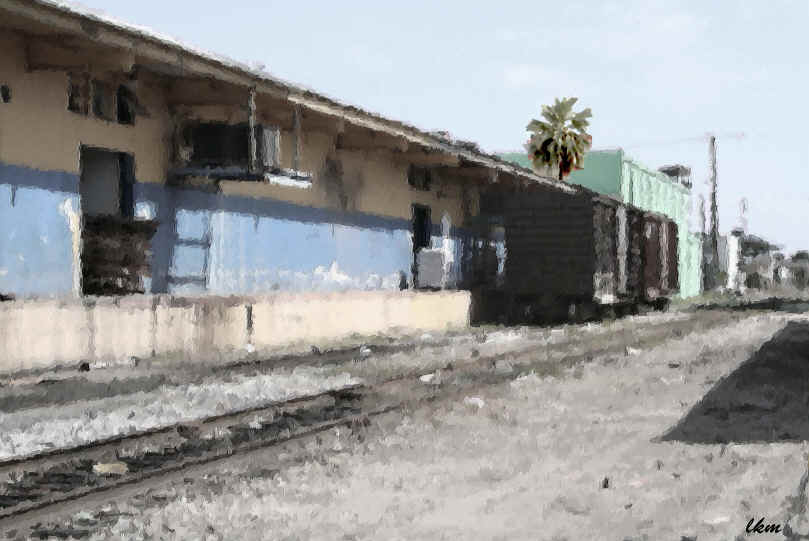 Lance
Mindheim models Miami's East
Rail
District. The site is divided into two
sections. The first section is a collection of
"photo paintings" edited from shots taken on his trip to
Miami in February of 2006. The second section
features images from the HO scale model railroad. Lance
Mindheim models Miami's East
Rail
District. The site is divided into two
sections. The first section is a collection of
"photo paintings" edited from shots taken on his trip to
Miami in February of 2006. The second section
features images from the HO scale model railroad. |
|
|
top |
|
|
top |
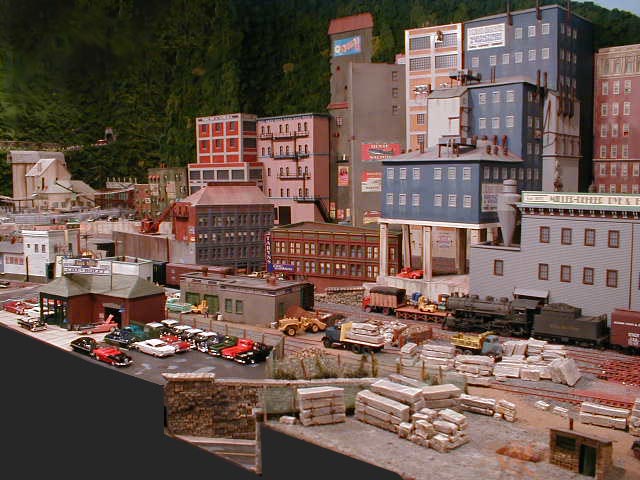 The Hudson Point and
Hawthorne Railroad is designed for "Point to Point"
Operation with optional "continuous running." Hudson Point
Yard represents the Eastern terminus of the railroad. The
only access by rail to the City of Hawthorne is via floats
and barges at the waterfronts. All of the track within the
City of Hawthorne is a separately operated railroad. The
city railroad is largely a switching operation. Real
estate on the city side is at a premium so the yard is
small. It takes very sharp railroaders to keep traffic
flowing in the city! Proprietor: Ken Spranza. The Hudson Point and
Hawthorne Railroad is designed for "Point to Point"
Operation with optional "continuous running." Hudson Point
Yard represents the Eastern terminus of the railroad. The
only access by rail to the City of Hawthorne is via floats
and barges at the waterfronts. All of the track within the
City of Hawthorne is a separately operated railroad. The
city railroad is largely a switching operation. Real
estate on the city side is at a premium so the yard is
small. It takes very sharp railroaders to keep traffic
flowing in the city! Proprietor: Ken Spranza. |
|
|
top |
| Visit the KayDee LugBahn. The KDLB is a European Lego train layout. |
|
|
top |
 Alan
Anderson's
HO-scale Kristenville & Michelleville
Railroad started in early 1977. Designed as a
freelanced 1920's era, steam powered railroad, it serves
the limestone quarries and Al's Brewery, each located on
the outskirts of Kristenville. The Board of
Directors recognized the potential for some logging
business and extended the line into the
mountains. The Kristenville Yard was expanded to its
present capabilities. Alantown boomed with the expanded
yard, the thriving K-M Sawmill Co., and the K-M Lumbering
Co. The small Michelleville Railroad near Passwater
Interchange was in financial trouble and was bought for
incorporation into the KMRR. Alan
Anderson's
HO-scale Kristenville & Michelleville
Railroad started in early 1977. Designed as a
freelanced 1920's era, steam powered railroad, it serves
the limestone quarries and Al's Brewery, each located on
the outskirts of Kristenville. The Board of
Directors recognized the potential for some logging
business and extended the line into the
mountains. The Kristenville Yard was expanded to its
present capabilities. Alantown boomed with the expanded
yard, the thriving K-M Sawmill Co., and the K-M Lumbering
Co. The small Michelleville Railroad near Passwater
Interchange was in financial trouble and was bought for
incorporation into the KMRR. |
|
|
top |
 The Long
Island
Rail Road Lower Montauk Branch provides maps of the
Long Island City Area 1953 and 1860, articles by Nick
Kalis, modeling hints, layout description, prototype and
layout photos, and a series of glimpses into industries or
warehouses that made for interesting freight operations on
the Long Island. Information presented includes a brief
history of the firm, how it was served by the LIRR, and
what commodities were received or shipped from this
facility. Proprietor: Nick Kalis. The Long
Island
Rail Road Lower Montauk Branch provides maps of the
Long Island City Area 1953 and 1860, articles by Nick
Kalis, modeling hints, layout description, prototype and
layout photos, and a series of glimpses into industries or
warehouses that made for interesting freight operations on
the Long Island. Information presented includes a brief
history of the firm, how it was served by the LIRR, and
what commodities were received or shipped from this
facility. Proprietor: Nick Kalis.Nick recounts, The layout existed from 2002 -2007. Completed by 2007 it appeared on the front cover of RMC September 2007 where a story by Ben Hom appeared. The layout with all its structures is currently owned by Ben Hom and another Potomac Division member. |
|
|
top |
 A lot of planning
has gone into the Nickel
City Line, an HO Scale model railroad set
in the Allegheny Mountains of Pennsylvania. The railroad
is a free-lanced short line railroad which operates 102
miles of single track mainline between Harrisburg,
Pennsylvania and Ridgway Pennsylvania. The railroad is
operations oriented. Operators run trains on a fast clock and adhere
to specific rules and instructions given by a Dispatcher.
NMRA Members who operate on the Nickel City Line can earn
hours towards their Chief DispatcherAP Certificate.
Proprietor: Bob Rodriguez. A lot of planning
has gone into the Nickel
City Line, an HO Scale model railroad set
in the Allegheny Mountains of Pennsylvania. The railroad
is a free-lanced short line railroad which operates 102
miles of single track mainline between Harrisburg,
Pennsylvania and Ridgway Pennsylvania. The railroad is
operations oriented. Operators run trains on a fast clock and adhere
to specific rules and instructions given by a Dispatcher.
NMRA Members who operate on the Nickel City Line can earn
hours towards their Chief DispatcherAP Certificate.
Proprietor: Bob Rodriguez. |
|
|
top |
 Jim
Brewer is in the process of building an HO scale model
railroad in his 3300
square foot basement depicting the Norfolk and Western
Railroad (now part of Norfolk Southern Railroad) along the
Shenandoah River between Hagerstown, Maryland, and
Roanoke, Virginia. The period is 1956; the transition
period of steam and diesel. Modeled is 80 miles of the
N&W Shenandoah Valley between Front Royal and
Waynesboro, Virginia, with Hagerstown and Roanoke
represented by eleven common staging tracks, each almost
40 feet long. Interchange is with the Southern Railroad in
Front Royal, the Chesapeake Western Railroad in Elkton and
the Chesapeake and Ohio Railroad in Waynesboro. Jim
Brewer is in the process of building an HO scale model
railroad in his 3300
square foot basement depicting the Norfolk and Western
Railroad (now part of Norfolk Southern Railroad) along the
Shenandoah River between Hagerstown, Maryland, and
Roanoke, Virginia. The period is 1956; the transition
period of steam and diesel. Modeled is 80 miles of the
N&W Shenandoah Valley between Front Royal and
Waynesboro, Virginia, with Hagerstown and Roanoke
represented by eleven common staging tracks, each almost
40 feet long. Interchange is with the Southern Railroad in
Front Royal, the Chesapeake Western Railroad in Elkton and
the Chesapeake and Ohio Railroad in Waynesboro.See a recent layout tour. |
|
|
top |
|
|
top |
 Howard
Zane’s
HO Piedmont
Division
of the Western Maryland Railroad showcases Fifties
era Appalachian railroading using equipment from the
Clinchfield, Western Maryland, Chesapeake & Ohio and
Norfolk & Western. Since 1992 Howard has increased the
layout area to 2850 square feet. Howard considers the
Piermont to be a painting created with plaster, paper,
foam, rocks and dirt where he can bring to life the fabled
coal hauling roads of the east. The railroad features
spectacular bridges, deep scenes and breathtaking vistas. Howard
Zane’s
HO Piedmont
Division
of the Western Maryland Railroad showcases Fifties
era Appalachian railroading using equipment from the
Clinchfield, Western Maryland, Chesapeake & Ohio and
Norfolk & Western. Since 1992 Howard has increased the
layout area to 2850 square feet. Howard considers the
Piermont to be a painting created with plaster, paper,
foam, rocks and dirt where he can bring to life the fabled
coal hauling roads of the east. The railroad features
spectacular bridges, deep scenes and breathtaking vistas.
|
|
|
top |
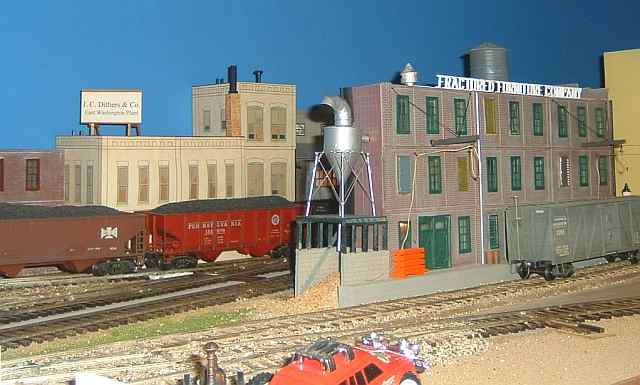 Ken Nesper's Baltimore and Ohio Shepherd Branch
is based on the former B&O's trackage in southeast
Washington, D.C.. To improve operational interest, the
number of businesses served along the branch were
substantially increased. The layout features hand-laid
code 125 and 100 rail to depict the lighter weight rail
used on branches and sidings. The rebuilt Old Pullman
turnouts are powered by Circuitron Tortoise switch
machines. The urban scenery is about 75% complete. The all
diesel operations are set in early 1958. Car forwarding is
managed by switch lists and the first generation
yard and road switchers are controlled using
Digitrax. Ken Nesper's Baltimore and Ohio Shepherd Branch
is based on the former B&O's trackage in southeast
Washington, D.C.. To improve operational interest, the
number of businesses served along the branch were
substantially increased. The layout features hand-laid
code 125 and 100 rail to depict the lighter weight rail
used on branches and sidings. The rebuilt Old Pullman
turnouts are powered by Circuitron Tortoise switch
machines. The urban scenery is about 75% complete. The all
diesel operations are set in early 1958. Car forwarding is
managed by switch lists and the first generation
yard and road switchers are controlled using
Digitrax. |
|
|
top |
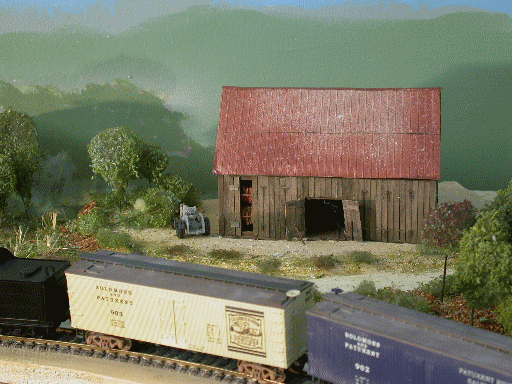 The
late Mike White was building the Solomons
and
Patuxent Railroad (the S&P) which was an HO
scale fictional short line operating between the villages
of Solomons and Owings in Calvert County, Maryland.
The right-of-way followed the real-world graded path of
the never-completed Baltimore and Drum Point Railroad for
most of its 30 or so miles through the county. It was a
country railroad serving rural people, businesses, and
industries in the Great Depression month of October 1936. The
late Mike White was building the Solomons
and
Patuxent Railroad (the S&P) which was an HO
scale fictional short line operating between the villages
of Solomons and Owings in Calvert County, Maryland.
The right-of-way followed the real-world graded path of
the never-completed Baltimore and Drum Point Railroad for
most of its 30 or so miles through the county. It was a
country railroad serving rural people, businesses, and
industries in the Great Depression month of October 1936.
|
|
|
top |
 Marty
McGuirk's
Southern
New England Railway (SNE), is
roughly
16 x 40 with a 9-foot long, 10-foot wide, "choke" point in
the middle. Current plans are for the railroad to start at
Tidewater - a port based on New London, Connecticut,
before running through several small New England mill
towns and ending at a small farming community. Several
other New England railroads will cross the SNE on its way
through the countryside, primarily the New Haven and
Boston & Maine. Marty
McGuirk's
Southern
New England Railway (SNE), is
roughly
16 x 40 with a 9-foot long, 10-foot wide, "choke" point in
the middle. Current plans are for the railroad to start at
Tidewater - a port based on New London, Connecticut,
before running through several small New England mill
towns and ending at a small farming community. Several
other New England railroads will cross the SNE on its way
through the countryside, primarily the New Haven and
Boston & Maine. |
|
|
top |
 Dave
Renard, MMR, built the Sylvania
Central
Railroad to depict the Central Division of an
eastern bridge road hauling mixed freight and passenger
traffic during the mid-1960s. With mostly an urban
setting featuring scratch-built and kit bashed
structures,trains run from a coal mining area to a
tidewater terminal with a rotary coal dumper. Three
hidden staging areas route trains over this central
division of a presumed larger line. Local way
freights out of Sylvania Yard share the mainline and
branches with through freight and passenger trains.
The 40-yr. old layout operates now with DCC and some
sound equipped locos. Several hundred figures and
small details along the right-of-way depict irony, satire,
and humor to the most observant. Subtle scenic
features incorporate materials collected from travels
around the world. Dave
Renard, MMR, built the Sylvania
Central
Railroad to depict the Central Division of an
eastern bridge road hauling mixed freight and passenger
traffic during the mid-1960s. With mostly an urban
setting featuring scratch-built and kit bashed
structures,trains run from a coal mining area to a
tidewater terminal with a rotary coal dumper. Three
hidden staging areas route trains over this central
division of a presumed larger line. Local way
freights out of Sylvania Yard share the mainline and
branches with through freight and passenger trains.
The 40-yr. old layout operates now with DCC and some
sound equipped locos. Several hundred figures and
small details along the right-of-way depict irony, satire,
and humor to the most observant. Subtle scenic
features incorporate materials collected from travels
around the world. |
|
|
top |
 Bernard
Kempinski's 1/48th - (O) Scale standard gauge model
railroad depicts the US Military Railroad (USMRR)
Aquia-Fredericksburg line in 1863. Set during the Civil
War the railroad includes a harbor with car ferry,
military bridges, camps, fortifications, as well as the
usual railroad facilities. The layout is
approximately 375 square feet with about 110 feet
mainline. All the track is hand laid track with stub
turnouts and code 100 rail. Easy DCC powers the time table
and train order operated layout. The modest stable of
brass locomotives hauls a fleet of scratch built cars. The
freight cars have wooden beam trucks with working brakes,
and link and pin couplers. Bernard
Kempinski's 1/48th - (O) Scale standard gauge model
railroad depicts the US Military Railroad (USMRR)
Aquia-Fredericksburg line in 1863. Set during the Civil
War the railroad includes a harbor with car ferry,
military bridges, camps, fortifications, as well as the
usual railroad facilities. The layout is
approximately 375 square feet with about 110 feet
mainline. All the track is hand laid track with stub
turnouts and code 100 rail. Easy DCC powers the time table
and train order operated layout. The modest stable of
brass locomotives hauls a fleet of scratch built cars. The
freight cars have wooden beam trucks with working brakes,
and link and pin couplers.
|
|
|
top |
| |
|
|
top |
|
|
top |
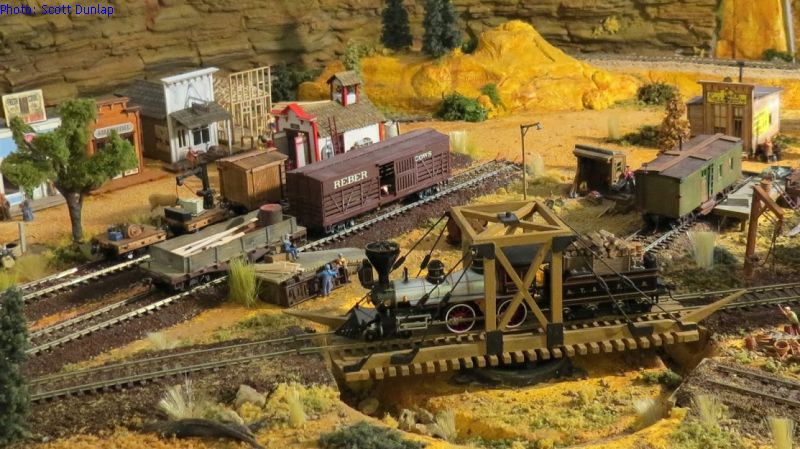 The Eureka and South Pass Railroad
is a fictional HO scale railroad located in Nevada in the
late 1890s. It is built around two mines and a logging
operation with sawmill. The town of Eureka features a
small train yard with a gallows turntable and a
repair-in-place building. South Pass is a village above
Eureka and home of the Lincoln Lumber Company. The small
DCC layout runs along three sides of a 2nd floor bedroom.
Proprietor: Alex Belida The Eureka and South Pass Railroad
is a fictional HO scale railroad located in Nevada in the
late 1890s. It is built around two mines and a logging
operation with sawmill. The town of Eureka features a
small train yard with a gallows turntable and a
repair-in-place building. South Pass is a village above
Eureka and home of the Lincoln Lumber Company. The small
DCC layout runs along three sides of a 2nd floor bedroom.
Proprietor: Alex Belida |
|
|
top |
| Ken Nesper's Ohio River and Western replicates narrow gauge operations in southeast Ohio, circa. 1912. The focus of this layout is on the representational county seat, Westfield, loosley based on Woodsfield, OH. The On30 locomotives and rolling stock are from Bachmann. Ken added Soundtraxx sound decoders and keep alives to the steam locomotives. Passenger operations reflect OR&W practices. Car forwarding is managed by switch lists generated by JMRI Operations Pro with the locomotives controlled by Digitrax. The level of scenic development increased dramatically in 2020/2021 with the addition of nearly a dozen structures. |
|
|
top |